How does Programmatic Contextual Targeting Help in ROI Increase?
PUBLISH DATE: 02 June 2022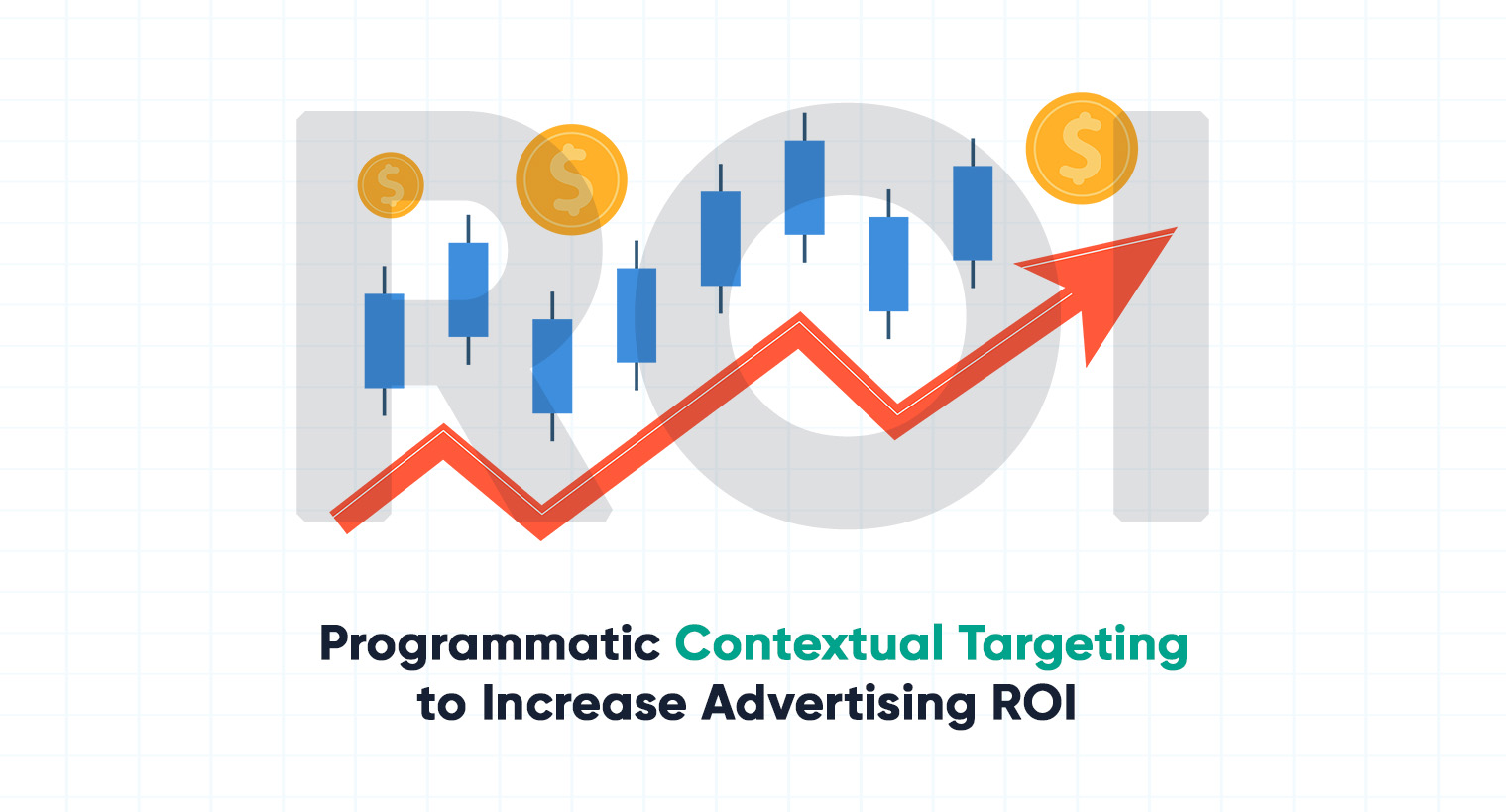
Contextual targeting is not something new that is hitting the advertisement industry. Time and again, it has helped advertisers reach their relevant audiences at the right time and place.
However, it is always a good idea to look for platforms that can catalyze the process further, and programmatic contextual targeting is exactly that!
The main motive of all brands is to see an uptick in the number of clicks and get a good return on their programmatic advertising (ROI) and contextual targeting has proved to be the best place to get started.
Contextual targeting has enabled advertisers to deliver highly targeted programmatic ads across a variety of online advertising platforms.
Moreover, this has helped in campaign effectiveness by allowing you to distribute these highly targeted, relevant advertising across a variety of media without developing several ad copies.
What is Programmatic Contextual Targeting?
The use of AI for acquiring advertising space is known as programmatic advertising or programmatic media buying. Data insights and algorithms are used to offer advertisements to the right person at the right time and at the right price.
With time, the popularity of programmatic advertising is rising. Projections are estimated that by 2021 $155 billion was spent on it globally. So, it’s not a surprise that more marketers are experimenting with programmatic ads.
Contextual targeting is one of the simplest ways to get started with programmatic advertising by utilizing terms that describe your product or service.
It helps in engaging new consumers on a large scale which is efficient for display advertising campaigns, including video and native advertisements. It has long been employed in search advertisements, but until recently, it was maybe employed in programmatic advertising.
So, let’s take a closer look at contextual advertising and how it works in conjunction with programmatic, thus helping companies increase their ROI.
Understanding Contextual Advertising and How it Works?
Contextual advertising is a tried and tested technique. It’s not something new, but it took a back seat for some time owing to the popularity of behavioral targeting.
However, with the adoption of new privacy laws all over the world and the decision by multinational companies like Google and Apple to ban third-party cookies, contextual targeting practices are rising again.
The technique of showing ads on web pages depending on their content is known as contextual advertising. It is the most effective method for companies to target people in a secure and privacy-compliant manner.
For example, you may have seen advertisements for running shoes in a news item about a 100-kilometer marathon or advertisements for headphones on a computer-selling eCommerce website.
Because contextual targeting includes segmenting advertising based on variables such as keyword or website subject, contextual advertising becomes more successful when combined with programmatic advertising.
Instead of matching campaigns to user profiles, contextual targeting connects the campaign with the website or pages and their content. By employing such tactics, the digital advertising industry may be able to develop a privacy-first and brand-safe approach for reaching out to and engaging people with the brand’s message.
Programmatic Contextual Targeting Leading to Increase in ROI
Programmatic Contextual advertising is a well-known performance marketing channel where the advertiser leverages the audience segmentation data to help brands deliver ads strategically to their consumers using contextual targeting.
Assume you are a home furniture company, then, both a home décor website and blogs would be the perfect match to display advertising about your products and services. This is because it increases the likelihood of conversion as individuals reading or visiting those pages would show some interest in your brand.
The main advantage of this form of advertising is that brands is can continuously access the same audience throughout the web and also be in front of the relevant audience at the correct time.
Contextual ad targeting combined with programmatic advertising enables advertisers to maximize their ad budget by bidding on high-value impressions, boosting their click-through rate, and experiencing a rise in their ROI.
Final Words
Leaving behavioral targeting behind, programmatic advertisements work best when combined with contextual targeting. With the help of contextual technology, advertisers are able to display ads on relevant pages and target the correct audience at the right time. This helps publishers and advertisers find new ways of reaching users with their ads. This kind of targeting helps to overcome losses because of the ban on 3rd party cookies and increases their CTR, VTR, and see a rise in their ROI.
Why Context Matters: The Significance of Contextual Targeting in Modern Advertising
PUBLISH DATE: 13 February 2023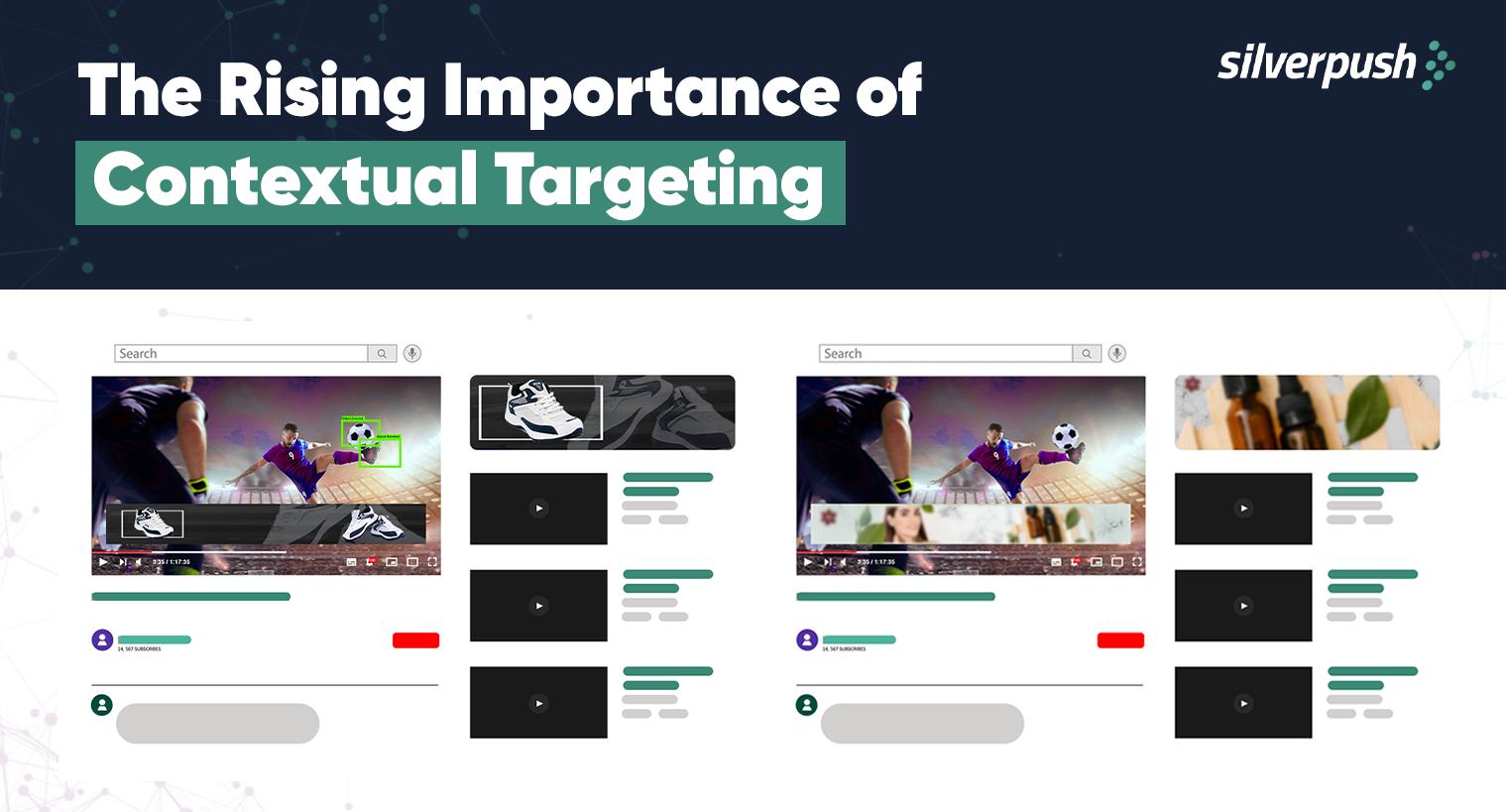
What happens when you are watching a video of a food blogger and an Uber Eats ad pops up? Will you click on the ad? The chances of this event are very high! The reason behind this is higher the relevancy of an ad served, the higher the chances of an engaged audience resulting in conversion. With the announcement of the ban on third-party cookies by major global companies like Apple, Firefox, and Google; ad-tech companies are striving to find new ways to display their ads without hindering users’ privacy. This is where contextual targeting steps in!
Before we move forward to explain the need for contextual ads and why it is gaining popularity these days, let me first walk you through their meaning, and how relevant ads are important for your campaigns.
What is Contextual Targeting?
Contextual targeting or advertising refers to the placement of a display ad on websites that are directly related to the product being offered in the ad.
Let’s understand this with an example. Have you ever come across a banner ad displaying flight bookings on a page offering tour packages in a country? If yes, you have experienced what contextual advertising is!
Simply put, in contextual advertising, the content of the ad is closely tied to the content of the site/page. It’s an old and simple strategy that wasn’t super popular earlier because its performance was lower than the ads that targeted contextual audiences using cookies.
Soon, it became the most dominant form of online advertising.
What are Relevant Ads?
According to Google, relevant ads or keyword relevance refers to how closely an advertising campaign matches a user’s search, based on the correlation between keywords, ads, and post-click landing pages. Relevant ads have the power to capture a user’s attention three times more effectively.
Additionally, contextually relevant ads have a greater likelihood of appearing in higher positions, generating more clicks, and leading to higher success rates for advertisers’ campaigns. Therefore, prioritizing the relevance of ads can be an effective strategy to increase the effectiveness of ad campaigns and drive greater ROI.
Problem With Behavioural Targeting Methods
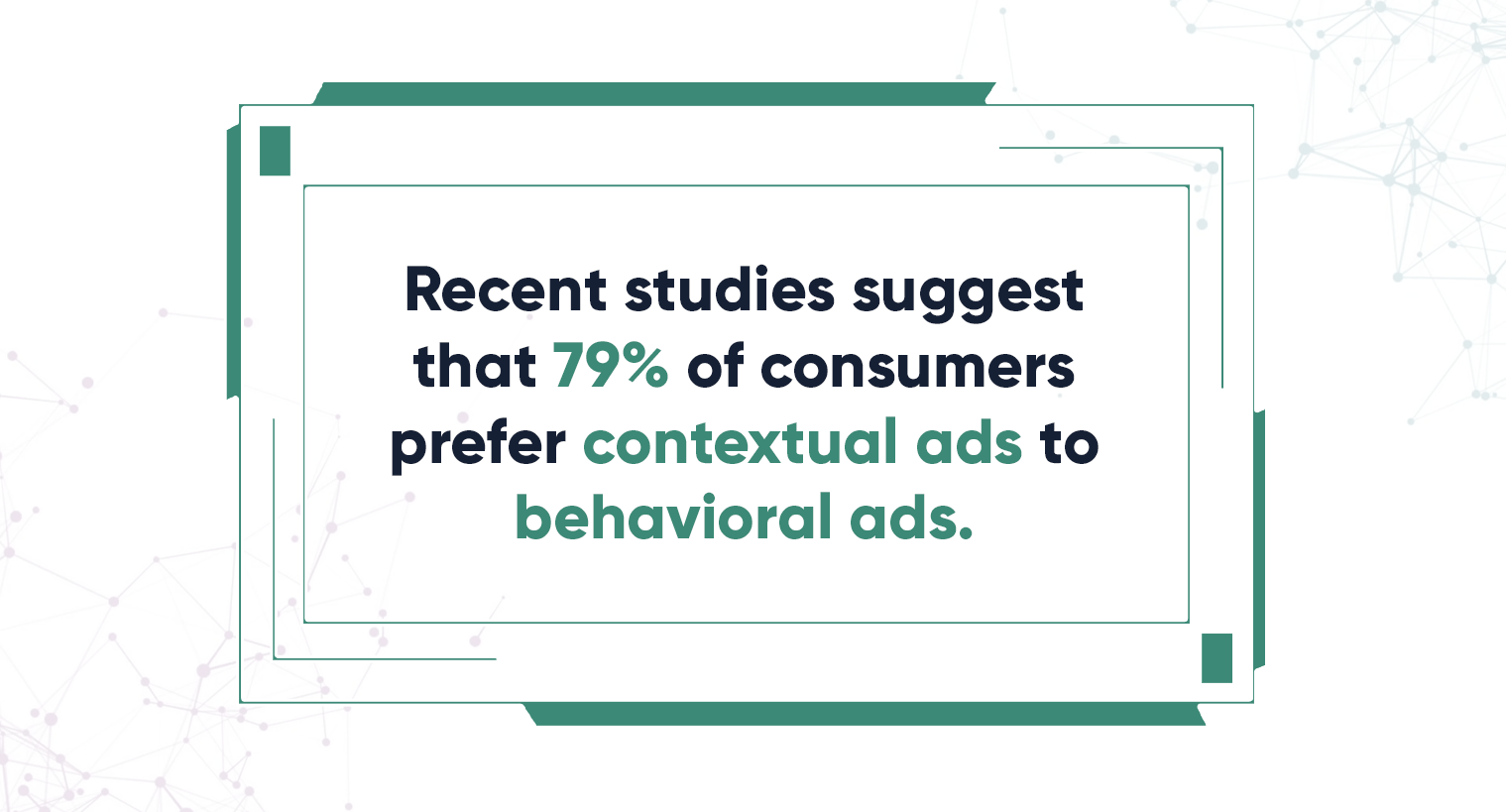
The difference between contextual and audience-based targeting comes down to intention. Contextual targeting is intended to increase user engagement by displaying ads that are relevant to the content being consumed, while behavioral targeting relies on users’ past browsing behaviors and interactions to serve personalized ads.
Personalized ads can sometimes creep out users who are uncomfortable with brands tracking their browsing history and habits. In fact, 66% of consumers have expressed discomfort with businesses and brands tracking their browsing history to serve them personalized ads.
By prioritizing contextual targeting over behavioral targeting, advertisers can create a more positive and comfortable user experience, while still delivering effective advertising messages that resonate with the user’s interests and needs.
Statistics Highlighting the Importance of Contextual Targeting
With privacy being at the top of the mind for advertisers, the importance of contextual advertisement and the relevancy of ads has never been more important!
1. According to reports and interviews with many people, the global market for Contextual Advertising estimated at US$199.8 Billion in the year 2022, is projected to reach a revised size of US$562.1 Billion by 2030, growing at a CAGR of 13.8% over the analysis period 2022-2030.
2. 49% of US marketers surveyed are using contextual marketing today.
3. Context is so powerful that 49% of brand marketers are looking to contextual targeting advertising to replace cookies.
4. Nearly 70% of consumers feel ads are more likely to be recalled when they appear next to relevant information.
5. 7 out of 10 viewers have said that consumer impression of an online ad and the brand linked with it is influenced by the content surrounding it.
6. When companies provide contextually appropriate ads, almost two-thirds (65%) of customers have a more favorable perception of those brands.
Why Should You Choose Contextual Targeting?
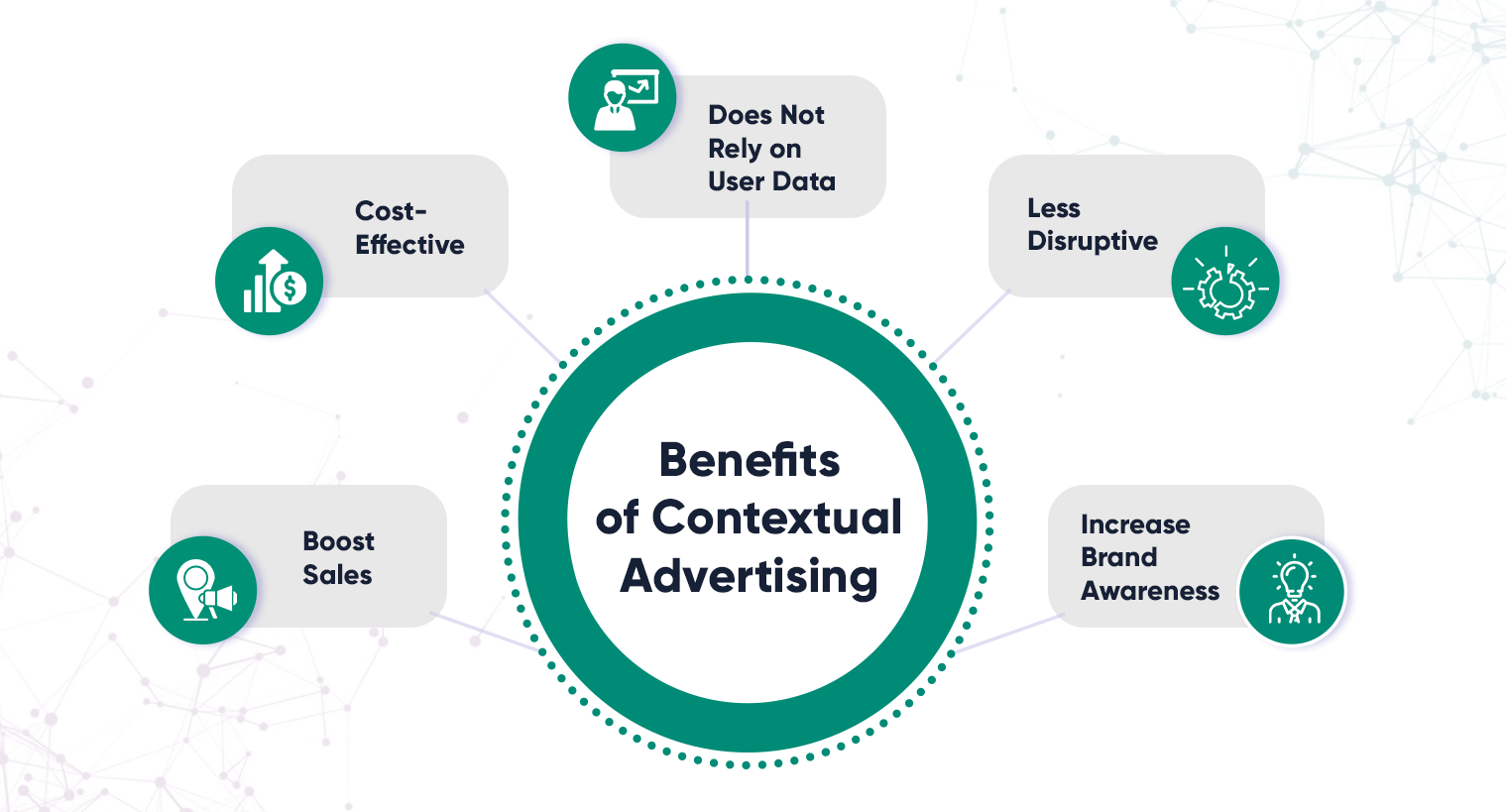
Contextual targeting is a demanded tool for companies that have helped them target their segmented audience group at the right time, moment, and platform.
About 65% of respondents said they would be more tempted to buy from online ads relevant to the web page they were currently viewing. Compared to this, only 35% said they would be tempted to purchase from an ad based on the content they had viewed in the last month.
Some of the benefits of contextual targeting that caused the new rise of contextual advertising are:
1. Unlike behavioral advertising, which requires users’ personal information, contextual targeting relies on less personal information. This makes it a secure and desirable option for most businesses that must adhere to privacy requirements such as GDPR.
2. Contextual advertising is less disruptive than typical banner ads since they are particularly targeted at an audience who is interested in the content of the page/video.
3. Unlike traditional advertising strategies, contextual advertising is cost-effective and does not hurt the advertisers’ pockets.
4. Contextual ad targeting is the most effective way to increase product sales by achieving its primary goal of reaching the targeted demographic. This occurs as a result of a good study on keywords, keyword phrases, and the application of AI technology.
5. When people visiting the websites see ads that are relevant to the content, the product’s brand recognition increases. This in turn leads to larger audience engagement and improves the company’s income through increasing sales.
How does Contextual Advertising Work?
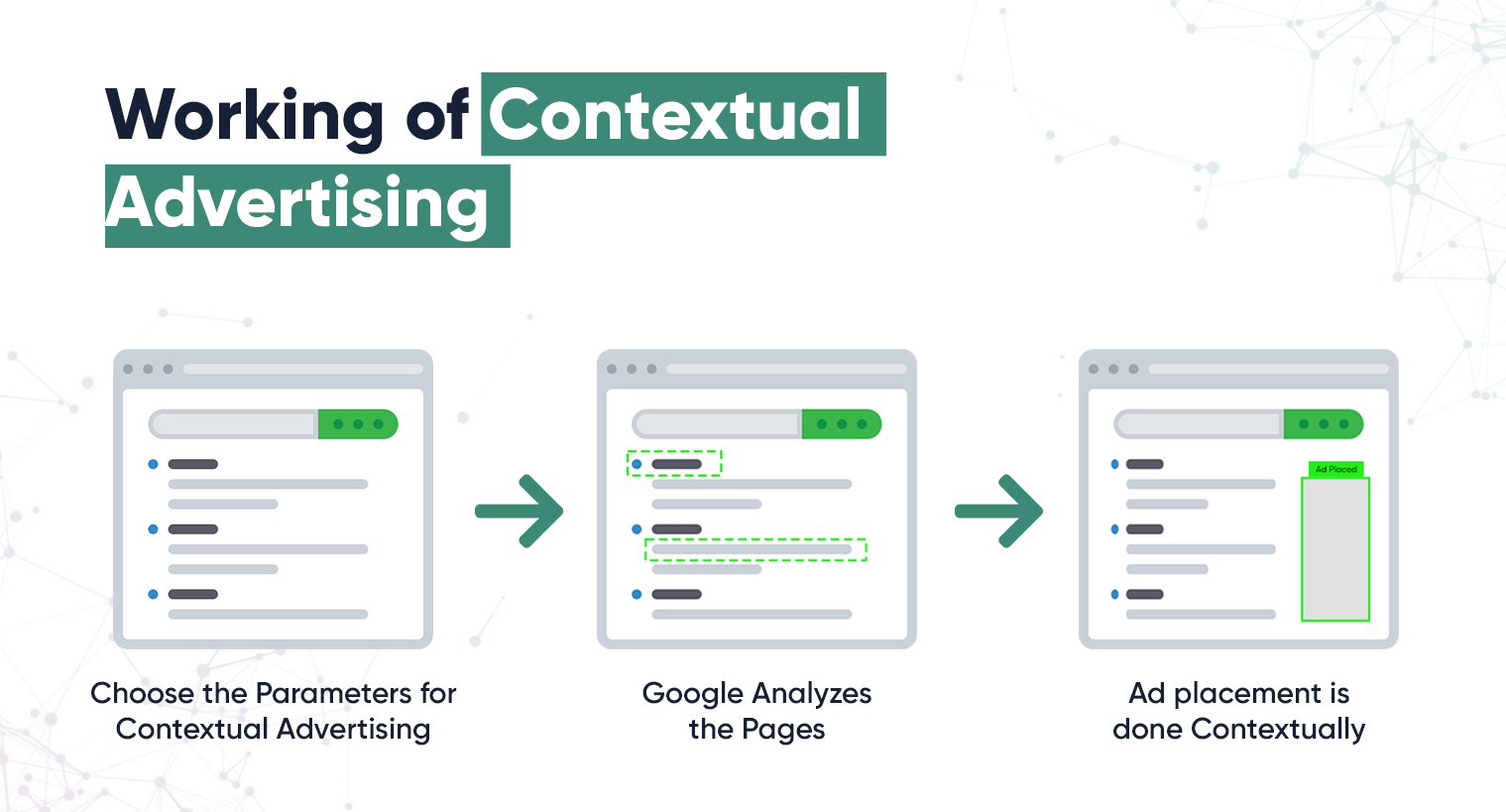
Now, here comes the real deal! Here, we have explained the workings of contextual advertising and the methodology behind it. It generally involves the process of contextual targeting through a demand-side platform that will place your ads on platforms that match the allocated parameters.
This is how the process works:
1st Step: Choose the Parameters for Contextual targeting
Keyword selection is an important step in this process. You need to target keywords, as well as topics and phrases to the Display Network ad groups. At first, you can start broad like ‘Autos & Vehicles’ and then can get more specific like ‘Trucks & SUVs’, or ‘Commercial Vehicles’, etc.
This is done to precisely target your topic and sub-topics. As per the research done by Google, each campaign should use 5-50 keywords, including negative keywords to help the network match your ad to website content.
2nd Step: Google Analyzes the Pages
Once you place an order, Google analyzes the pages to the web page which matches your ad with the most relevant content. In case, you target keywords in the same ad group, your content is displayed first when Google selects where to show your ads.
3rd Step: Ad placement is done Contextually
After Google analyzes your ad, the display network will find the placement of your ad contextually. For example, when keywords, as selected by you, match the central theme of a website, or the concept of that site, your ad is then shown up on that website.
Third-Party Cookies Out, Contextual Advertising In

Consumers worldwide are becoming more informed and public and governmental demands are increasing on the advertisement industry to restrict or limit the gathering of user data.
As a result, cookie-based ad targeting is becoming increasingly difficult, and many internet browsers are now taking steps to limit cookie use.
With GDPR and CCPA legislation requiring greater use of personal data and privacy protection, there is an increase in demand for contextual targeting.
The best part about contextual advertisements is that they do not require any personal information from consumers to target them. Instead, they analyze session data, such as a user’s current webpage, to establish the individual’s intentions and interests. Interpretative data is obtained from the user’s activity.
Brand Safety and Suitability – Important Part of Contextual Targeting
According to a study, 43 percent of customers have stopped doing business with a brand in which they have lost trust.
Brand safety and suitability are critical for maintaining a brand’s reputation in the digital advertising space. In today’s digital world, customers are quick to lose trust in brands that fail to ensure brand alignment, which can result in losing clients. It is, therefore, essential to protect the brand at all costs.
To ensure brand safety, digital marketers, agencies, and media need to implement effective brand safety policies. These policies should aim to prevent the brand’s ads from appearing next to harmful or inappropriate content online.
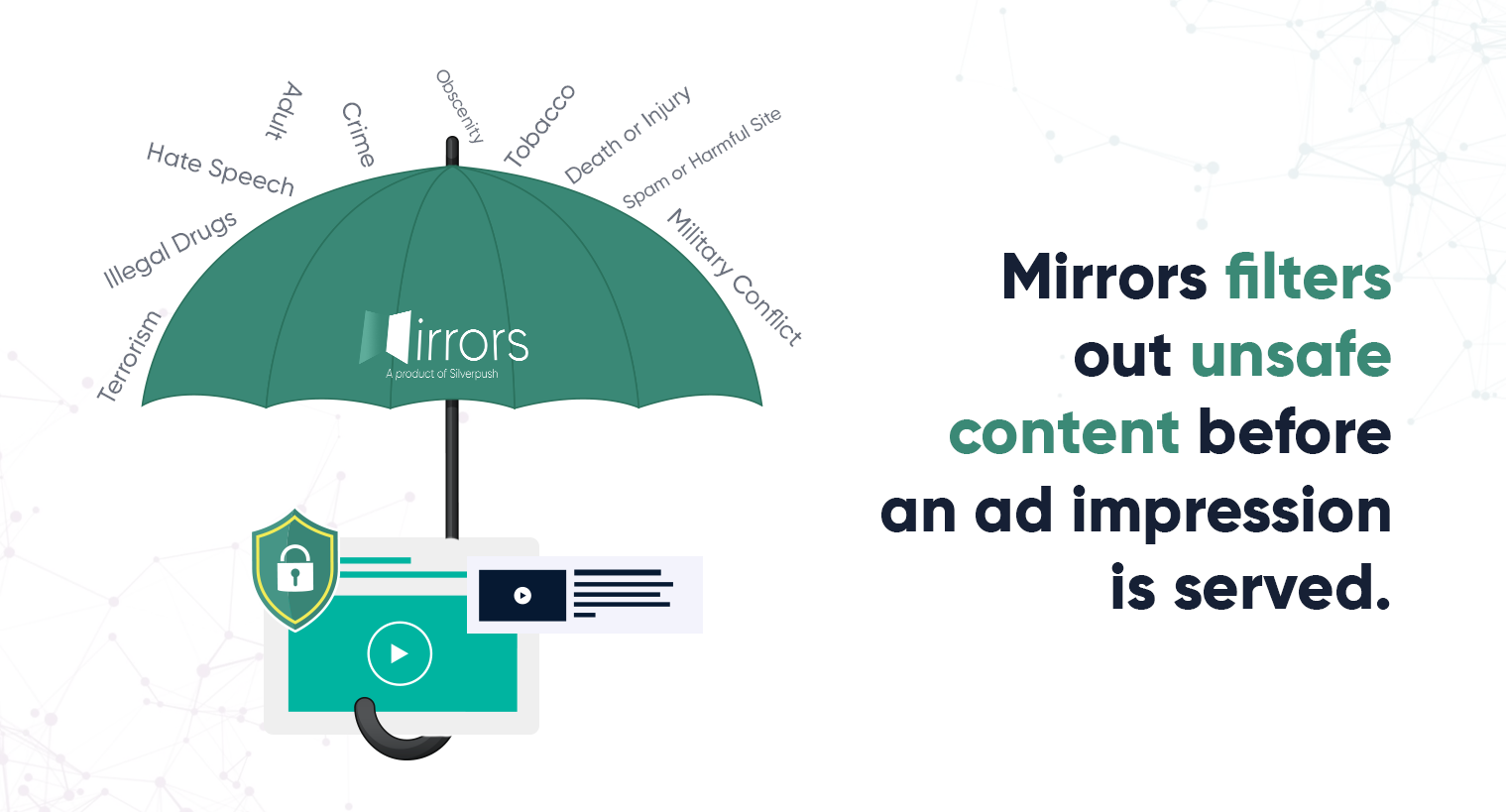
One way to achieve this is through context-based controls that target safe, acceptable, and brand-building content. Digital marketers should prioritize brand suitability to protect the brand’s reputation and build a positive brand image in the minds of their target audience.
To help achieve this, Silverpush’s contextual targeting solutions can be a valuable tool. Silverpush’s solutions use advanced algorithms to analyze and understand the context of a web page or video and determine its suitability for a particular brand. This helps ensure that the brand’s ads appear only on appropriate content and not on content that could damage the brand’s reputation.
Silverpush – Placing Ads in Contextual Moments
With third-party cookies being phased out, it has become even more important for ad-tech companies to find better ways to engage with customers, the alternative to this is contextual targeting!
Know Mirrors
Silverpush’s flagship product, Mirrors is an AI-powered contextual targeting solution that focuses on serving personalized ads to the audience in a completely brand-safe environment. Initially, it was available on YouTube, now its contextual and brand-safe solutions are available on the OpenWeb and social platforms as well. It enables the processing of large volumes of data at speed, with better context, at a higher scale, and improved targeting efficiency.
How Mirrors Can Help in Reaching Your Relevant Audience?
Mirrors’ AI-powered technology identifies key contexts like celebrities, brands, objects, actions, and other factors for a nuanced level of targeting at the video level. Its unique custom identifying capabilities ensure that reach is not duplicated, and a unified approach is followed for content-aligned ad placement, brand safety, and custom brand suitability.
It can block ad placements against unwanted, unsuitable, irrelevant, and harmful content.
These solutions can provide the highest accuracy to not let a single damaging ad placement pass through, by using word-by-word parsing of video content. An example of this is its tie-up with IKEA, where it helped the company achieve CTR of 0.55% and 104% view rates with Mirrors.
To know more about Silverpush and its AI-powered solutions, fill out the form on the right and an expert from our team will contact you soon.
How do Images and Videos Help Deliver Contextual Ads?
PUBLISH DATE: 13 May 2022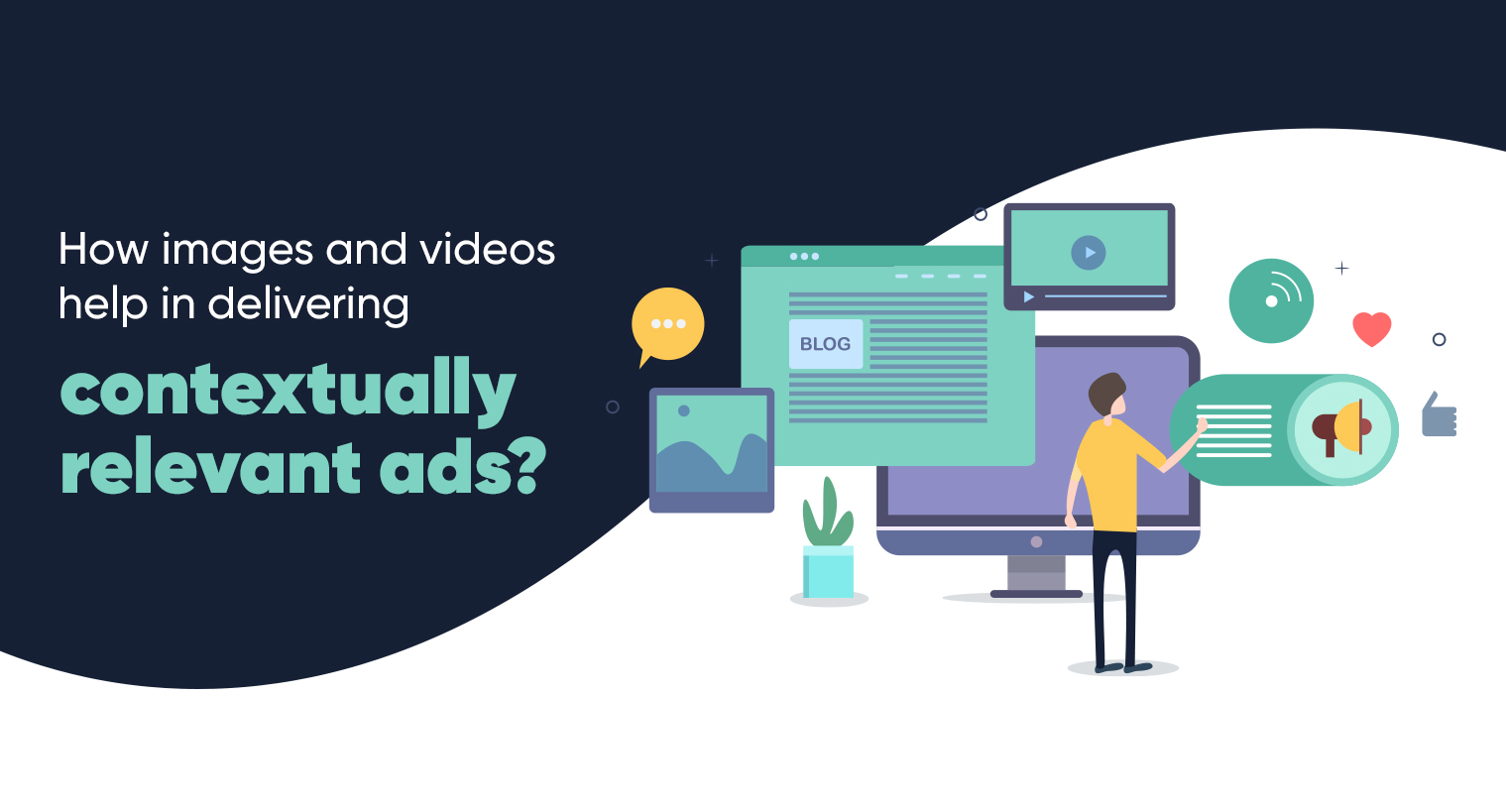
Contextual advertising or contextual targeting means displaying ads on a website that is relevant to the page’s content. An example of contextually relevant ads can be serving ads to buy movie tickets or signing up for a movie streaming service on a movie review blog.
With third-party cookies on the verge of complete phase-out, brands are looking out for alternatives to it. There is nothing better than contextual ads that do not require any user’s data, thus respecting the user’s privacy completely.
The best way to use contextual ads is to deliver them on images and videos, as they form the most interesting form of content. Do you want to know how? For that, keep reading!
But before moving forward let’s dive into the details and understand what is contextual advertising and how important it is in today’s era.
What is Contextual Advertising?
Contextual advertising refers to the placement of a display advertisement on websites that are closely related to the product being advertised. As a result, the content of the ad is closely tied to the content of the site/page.
Most importantly, it aids in targeting the right audience at the right time and place, converting them, and increasing ROI. An example of this is displaying utensil ads in a home décor magazine.
Importance of Contextual Advertising in the Adtech Industry?
The benefits of contextual ads make it one of the greatest advertising methods, outweighing all other types of advertising approaches. Let’s find out what they are.
- Easy and Cost-Effective Advertising Method
Because behavioral advertising needs a large amount of data, methods for obtaining and interpreting it, tactics for exploiting it and people to enhance the process, are all required.
This strategy, however, is impractical for organizations with limited resources and client data. In its place, contextual advertising provides a simple and low-cost alternative, as well as a level of relevance in its own right.
- Brand Safety & Suitability
Behavioral advertising raises serious concerns about brand safety and brand suitability. Contextual targeting, on the other hand, places the web page where the ad appears at the center of the campaign.
It is also totally up to you to choose the themes, subtopics, and keywords. This reduces the likelihood of your ads following a user to a site where they do not want to see the ads and where you do not want them to appear.
- Prioritizing User Privacy
Contextual advertising is one of the most effective ad delivery tactics since it does not require any sensitive personal information. This is safer for advertisers who want to guarantee that their ads are compliant with the privacy laws.
- Relevant But Not Pushy
Some firms’ ads follow customers long after they have purchased something. Poor advertising results when advertisers constantly target their customers. Contextual ads help to keep relevance without annoying the viewer.
A user is less likely to feel followed by advertising if it is related to the material they are now seeing. Even though the advertisement follows the user around, it is much less obvious when it is contextually appropriate.
- Context Matters More Than Behavior
Advertisers recognize that customization is a powerful marketing tactic. This is just because it makes an advertisement more relevant. Furthermore, an ad adapted to previous behavior isn’t necessarily totally relevant to present desires or requirements.
Role of Images and Video in Delivering Contextual Ads
Images and videos are highly interesting and most sought after forms of online content. AI-powered solutions are now available that deliver contextual ads against online images and videos, thus generating high engagement.
Such contextual advertising solutions offer intelligent in-video identification of key contexts that identifies celebrities, brands, objects, places, actions, on-screen text and audio for a nuanced targeting of videos and images.
The AI-driven and human-enhanced contextual video advertising technology helps brands reach their target audience at the correct time and in the right context.
The deeply trained proprietary AI models also identifies key contexts including custom-defined unsafe contexts in streaming videos and don’t display your ads against them. These videos are divided into different categories including smoking, adult, violence, crashes, guns, terrorism and others.
Content-aligned ad placement, brand safety, and customized brand compatibility are all ensured during the process, as is reaching the widest potential audience.
Learn about Mobile Contextual Advertising
PUBLISH DATE: 09 May 2022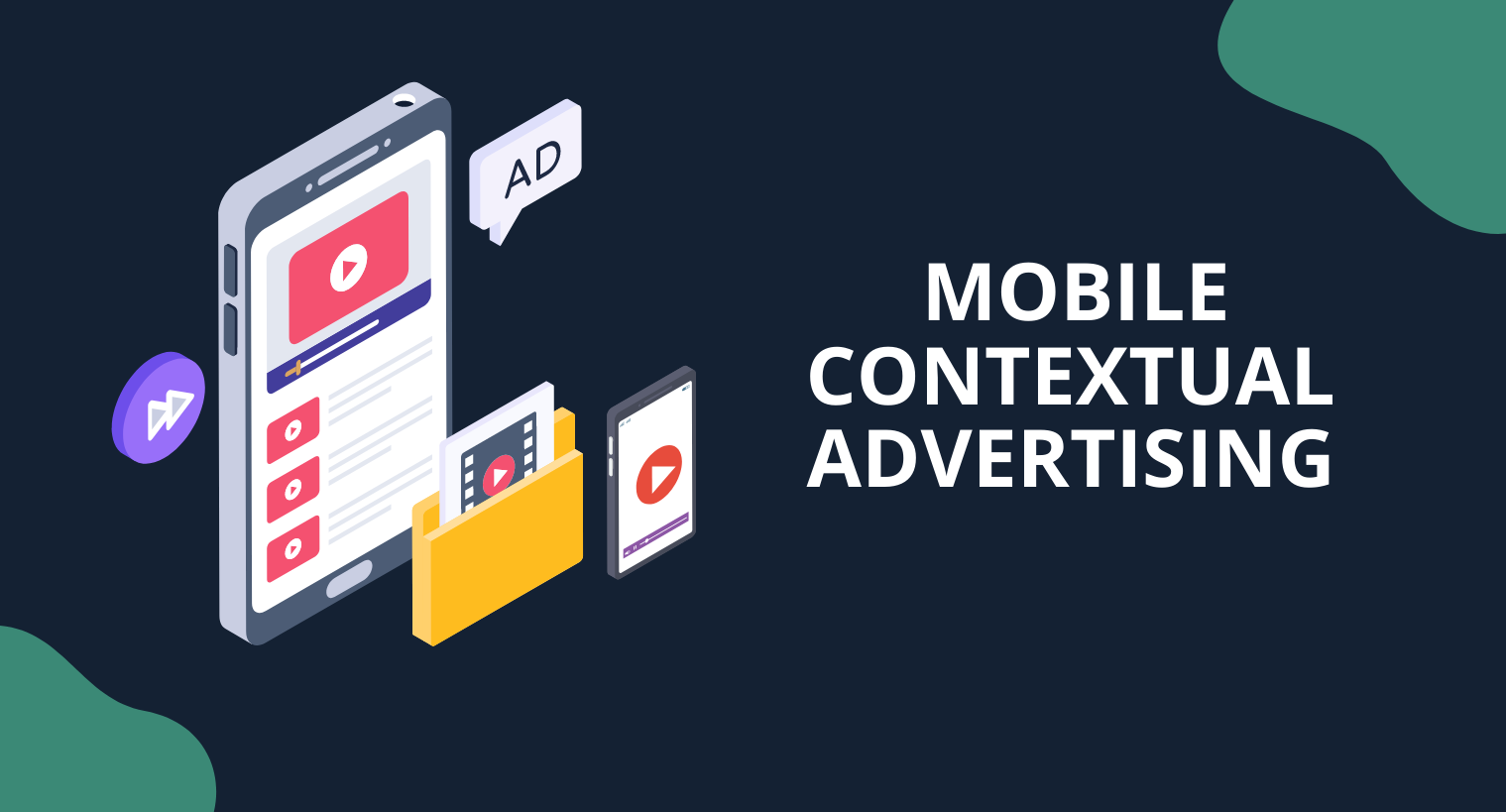
Contextual advertising is a tried and tested marketing strategy that is even more effective when combined with the efficiency and scale of programmatic mobile app advertising. Focus on relevant advertising isn’t new.
Perhaps, it’s one of the oldest strategies in digital advertising. Before we begin to talk about contextual targeting for mobile, let’s just quickly clear out some basics.
What is Contextual Advertising?
Contextual advertising is the practice of displaying advertisements on web pages or online videos based on their content. It is the best approach for brands to target users in a safe and privacy-compliant manner. For example, you might have seen ads for spectacles in a news article featuring information about some books, or ads for earphones in a music video.
It took the back seat for a few years as behavioral targeting became the prime focus of the advertisers. However, contextual targeting is rising again and re-shaping the digital marketing landscape as all the popular browsers such as Apple’s Safari, Google Chrome, and Mozilla Firefox have announced the ban on third-party cookies.
The advancement of programmatic mobile application advertising means that contextual targeting for mobile can now be used with a greater effect than before. It’s an excellent combination but marketers should be aware of some noteworthy differences between desktop and mobile contextual advertising techniques.
How does Mobile Contextual Advertising Work?
The same tech that applies to the desktop contextual targeting are also used in the mobile-app world, but with a few additional factors in the role. Just like the concept of desktop contextual advertising, an ad for a banking offer would definitely perform well on a stock tracker app on mobile devices. Mobile contextual factors like battery level, OS version and available device storage provide additional targeting efficiencies. In the programmatic world, these factors are amplified through the continued in-app bidding on mobile.
Combining mobile contextual advertising with programmatic advertising is the great use of the two strategies. While first-party data will constantly enjoy some upper hand over different techniques, it may not be enough to accomplish your user engagement goals. In that scenario, contextual targeting can assist advertisers reach target audiences based on factors like app category and device information. Contextual advertising in programmatic targeting makes that process very convenient, allowing marketers to quickly adjust a campaign in response to its performance.
The Right Mix
Mobile contextual advertising mixed with programmatic advertising allows marketers to increase their ad budget by bidding on high-value impressions — and change what “high-value” means on the fly. The right mix gives you the power to leverage data in real-time to ensure you’re optimizing your spend.
To learn more about contextual advertising, don’t miss to check out our blog section.
Contextual Targeting: A Smart Way to Reach Your Customers!
PUBLISH DATE: 06 May 2022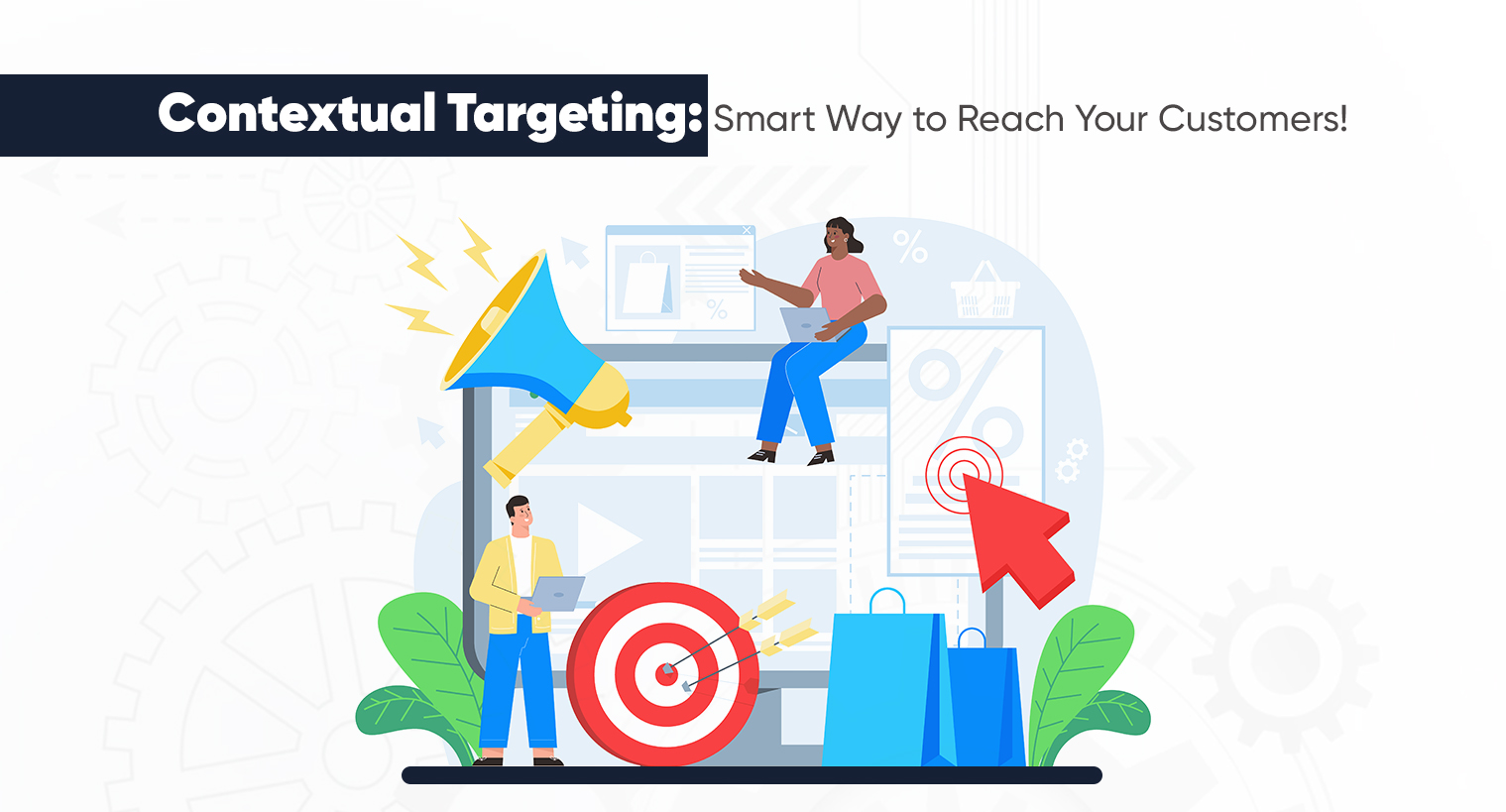
Google Chrome is all set to phase out third-party cookies soon. The decision came as a boon to the users but a bane to the advertisers who were relying on cookie-based targeting methods for advertising their brands. Behavioral advertising has been helpful for advertisers for years in tracking their users on different sites.
Now, the marketers are in a huge dilemma as they have to find the best substitute to the third-party cookies that can help them in targeting the right audience and result in the positive growth of their advertisement campaigns.
Well, why go far when you have the best option on the table. Yes, we are talking about “contextual targeting.” This form of targeting is the best and most effective way of advertising as it doesn’t rely on the user’s data but on the context of the content.
What is Contextual Targeting?
Great question to begin with! So what exactly is contextual targeting? Contextual advertising is the form of advertising in which ads are shown based on the context which the target audience is viewing or is interested in watching.
For Example, let’s assume an advertisement of a treadmill being displayed on a fitness related video – will it motivate the user to click on the ad and think of buying the treadmill? The chances are high that the user might click on the ad after getting inspired by the video content. Contextual advertising majorly focuses on the context of the user rather than who the user is. So, in this manner it doesn’t require any demographic or personal information of your user.
Is Contextual Advertising a New Form of Marketing?
The answer is a clear “No”. People who are into the advertising industry from more than a decade would be familiar with the concept of contextual targeting. Not just online behavioral advertisements, but contextual targeting has been used on online media for a long time now. But, because of the evolution of data-tracking techniques, marketers shifted from contextual advertising.
Contextual Targeting Offers a Smart Form of Advertising
The evolution of the ad serving techniques has been very advantageous to the advertisers who advertise their goods and services online. Contextual targeting allows brand owners to display their ads on relevant content without having to put their resources into tracking users’ data.
For marketers, it has boosted their options of conveying advertisements to the right audience, without the need of knowing or studying their online behavior.
The contextual form of advertising is getting further more effective with the use of AI-powered targeting tools. So, yes it won’t be wrong to say that contextual targeting is a smart way to advertise online.
To know more about contextual advertising, read our blog: Contextual Advertising Is More Cost-Efficient Than Behavioral Advertising.
Is Contextual Advertising a Substitute for Cookie-Based Targeted Advertising?
PUBLISH DATE: 12 April 2022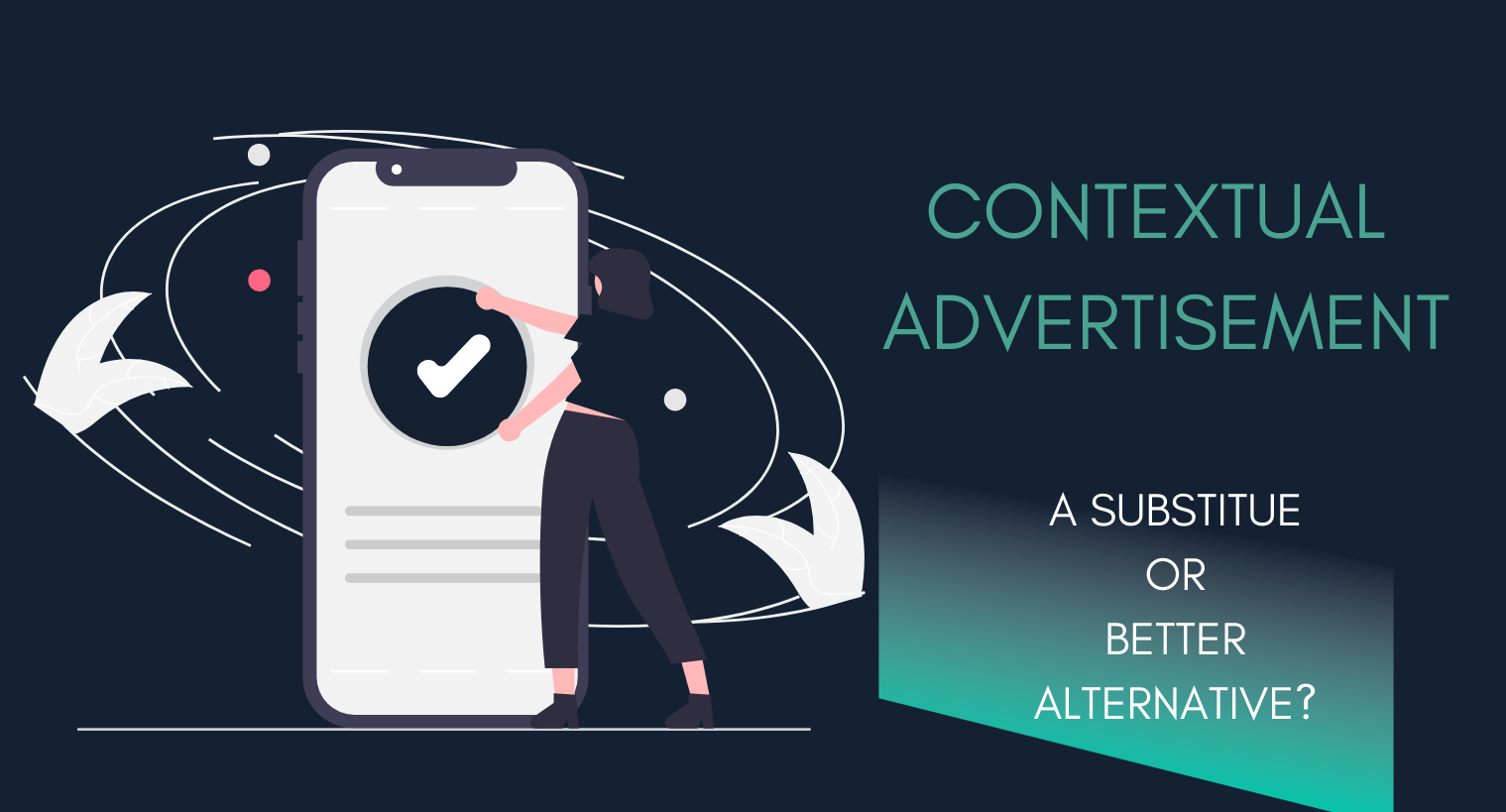
With the world on the web considering privacy and security their priority, the major web browser companies like Mozilla Firefox, and Apple were left with no choice but to phase out third-party cookies. Google Chrome is also to phase out these cookies soon. This might come as a boon for users, however similar is not the case with advertisers. Targeted advertising using third-party cookies has helped brands for years in tracking users across different sites.
The major concern remains to find an alternative or substitute to third-party cookies that will not only target the correct audience but also provide a positive ROI with effective campaigns.
Is Contextual Advertising a Better Alternative to Cookie-Based Targeted Advertising?
Contextual advertising is the practice of displaying advertisements on web pages based on their content. It is the best approach for brands to target users in a safe and privacy-compliant manner.
For example, you might have seen ads for running shoes on a news article featuring a 100 km marathon or ads for headphones on a computer-selling eCommerce website.
This is accomplished by contextual targeting, which includes segmenting advertising based on criteria such as keyword or website subject.
Instead of matching campaigns to user profiles, contextual targeting aligns the campaign to the website or pages and its content. By using such strategies, the digital advertising sector may work towards building a privacy-first and brand-safe strategy to reach out to and engage audiences with the brand’s message.
Contextual ad targeting is more than just a third-party cookie substitute. Rather, it is apt to say that it is better than cookie-based targeted advertising and is the future of digital advertising.
Reasons Why Contextual Advertising is a Better Option than Cookie-Based Targeted Advertising
Cookie-less advertising is the future of digital advertising, and it is set to revolutionize the $330 billion industry soon. It is the most effective method for establishing a relationship with the audience by being in the right place at the right moment.
The following are some of the reasons why first-party data and contextually targeted advertising can help both advertisers and publishers.
- No Dependency on Third-Party Cookies
It is no longer a secret that customers are apprehensive about sharing their personal information. Fulling this need, contextual online advertising is the best option. It does not rely on cookies or personal information to provide appropriate ads. This is why brands now want to spend their budget more wisely by using contextual-based ads.
- Brand Safety and Suitability
Other issues that contextual targeting may solve are of brand safety and brand suitability. Most businesses are concerned about their advertisements appearing next to content connected to terrorism, drugs, violence, and other topics that may reflect negatively on the advertiser and the brand. To solve this, they use basic blocklists or out-of-date technology to detect and highlight keywords without considering their context.
This implies that even when businesses focus on brand safe advertising on web pages, they may still find their ads displaying on inappropriate websites, disrupting their image.
Context-relevant targeted advertising using Mirrors by Silverpush aids in resolving such challenges. Its AI-powered in-video context recognition provides brand safety restrictions without limiting your reach and addresses over-blocking issues.
Read our case study on how Castrol built brand relevance with Mirrors.
- Simple and Easier Implementation
Cookie-based targeted advertising needs massive amounts of data. It needs not just the appropriate tools and technology for collection, but also a staff that is needed to evaluate data.
Contextual advertising, on the other hand, focuses on predictions made by AI based on patterns and other data that makes it a more user-friendly tool.
- AI Advancements have Improved Context Accuracy
AI has become increasingly adept at assessing page content and displaying your ad to viewers who are more likely to be interested in viewing it as a result of technological breakthroughs.
This can enhance the number of leads and conversions you receive. AI also alleviates the stress on your team by practically reducing the human effort needed in segmenting audiences by finding trends and learning from previous jobs.
- Better Weather Targeting can Drive Sales
Another crucial, but often underestimated, aspect of contextual advertising is the weather. While the weather may appear insignificant, it may provide valuable information on how customers would act based on their location and weather.
Contextual Advertising: The Advertising Industry’s Next Big Step
PUBLISH DATE: 11 April 2022
Seeing laptop ads in the Science and Technology section of a newspaper or stumbling upon a shoe ad while watching a YouTube video about running tips, contextual advertising has always been relevant and impactful.
With Apple’s new iOS 14.5 privacy policy and Google Chrome’s pending ban on third-party cookies, all ad-tech companies are striving to find new ways to sell their ads without hindering users’ privacy.
As targeted and behavioral marketing becomes increasingly challenging, contextual advertisements have evolved as a solution that targets the correct audience with context-relevant ads while respecting their views on data privacy and personalization.
What are Contextual Ads?
The year 2024 will see the rise of contextual advertising. It is a powerful and effective method of reaching the target audience by displaying ads on a webpage that matches the ad’s content. At the same time, it ensures a seamless ad experience for both advertisers and viewers.
Let’s understand contextual ads better with some examples:
- If you’re reading a movie review site, you could see ads that say things like “purchase movie tickets” or “join up for a movie streaming service.”
- Before watching a YouTube video lesson on “how to cut your own hair”, you view an ad for “shampoo”.
Here, instead of using consumer data, Keywords, Topic Targeting, and AI Technology are used to scan the website on which the visitor currently is. Then, ads that are relevant to the page’s context are displayed.
Also read: The Role of Context in Advertising
Advertisers’ Future is Contextual
Contextual advertising is surely the future of advertisers. According to a research study, contextually relevant ads create 43% higher neural engagement and 2.2 times better ad recall.
Where on the one hand, consumers are pleased to find their personal data better protected, on the other hand, they also expect to see ads that match their interests and are relevant to their online experience. This is where the magic of contextual targeting comes into play.
By reaching target audiences with relevant ads, brands satiate their need to find an alternative to target the correct audience at the correct time and place with personalized ads in the cookieless world.
Moreover, unlike behavioral marketing, contextual ad targeting does not need third-party cookies to deliver relevant ad experiences to the user. It is the best fix for advertisers when privacy is a major concern, and they still want to have a phenomenal impact on users.
Benefits of Contextual Advertising
1. Meets your Budget
Unlike conventional methods of advertising, contextual advertising is cost-effective and does not hurt the pockets of the advertisers. They are charged only for the ads that are clicked and not for ads that are displayed on the site.
2. Reaching Targeted Audience
Fulfilling its main motive by reaching the targeted audience, contextual ad targeting is the best method to boost sales for a product. This happens because ads are posted after proper research on keywords, keyword phrases, and the use of AI tech.
3. Ability to Engage with Customers
When the people visiting the websites find ads relevant to the information, it boosts the brand awareness of the product. This engages more audiences and thus increases the revenue of the company by increasing its sales.
4. User Privacy is Not Compromised
The best feature of contextual advertising is that it does not require any 3rd party cookies to offer relevant ads. This plays a major role in meeting compliance requirements like CCPA and GDPR.
Silverpush’s Contextual Advertising Solution
With third-party cookies being phased out, engaging with customers has never been more essential. Silverpush’s flagship contextual ads targeting solution Mirrors helps in context-relevant video-level ad targeting using human-enhanced AI technology. During the process, content-aligned ad placement, brand safety, and tailored brand compatibility are all guaranteed, along with reaching the largest possible audience.
How Contextual Advertisement will Become the Next Digital Marketing Trend?
PUBLISH DATE: 22 March 2022
Contextual advertisement has been on the plan of digital advertisers lately. The primary motivation for this is the guidelines that both government and brands have brought in user privacy protection. Contextual targeting will be an exciting topic in the new online shopping world to emerge after these guidelines.
What is Contextual Advertisement?
It’s pretty simple and easy! Contextual advertising is ads shown based on the context of the target audience group. It resembles seeing a sports shoe ad on a sports news channel or website. Contextual advertising centers around the context of the customer rather than who the customer is. Similarly, the requirement for demographic and psychological information of the client to show the right ad is eliminated.
Is Contextual Marketing New in the Market?
No. If you’ve been in online advertising for over ten years, you must know that the answer to this question is no. Contextual advertising has been used for quite a long time in all media, not just online advertisements. However, because of the development of user-tracking techniques, advertisers have moved away from contextual advertising.
What are the Top Advantages of Contextual Advertisement?
Lesser Reliance on User Data
Contextual ads can be a perfect solution to the cookie issue, which is the most crucial issue advertisers have faced in recent times. Since the targeting in contextual marketing depends on the context, not the behavioural data of the client, the reliance on cookies that create data privacy issues has decreased.
Less Ad Fatigue
One of the most significant inconveniences of behavioural advertising is that it displays the same advertisement to the same user repeatedly. In contextual advertising, although the same ad is often shown to the user, advertisement fatigue is decreased because these advertisements are relevant to the content the user is consuming.
Brand Image Protection
Undoubtedly, one part of safety is legal compliance. But, the image can be something trickier to protect, especially because advertisers can’t always control where their ads are displayed. Often, brands have faced trolls because they showed their ads on adult sites or with extremist perspectives. It, however, was an outcome of user activity. In contrast, Contextual advertising puts the webpage at the centre of things. The brand has command over that web page by specifying the topics, subtopics, and keywords that connect with the promotion.
Greater Relevance
The primary assumption supporting behavioural advertising is that clients want to see advertisements related to general trends in their surfing conduct. But, it could also happen that their current needs don’t fall in with those trends. For example, somebody reading home appliances may not need to see advertisements about website designing services, even if they have recently searched for them. On the other hand, a YouTube contextual ads for healthy protein powders might be more relevant to their present state of mind and draw in more clicks.
No Worry about Banner Impairment
There is a common phenomenon where clients have learned to ignore ads. For example, a bus ticket booking site running advertisements for a bus review platform makes better sense than displaying YouTube contextual ads related to women’s clothing.
Why Advertisers Moved Away from Contextual Ads?
Advertisers have moved from contextual advertising solutions since cookies-based behavioural advertisement models have beaten contextual promotion models. But, it is incorrect to say that contextual advertising has vanished.
Brands that explicitly own a specific niche continued to be clients of contextual targeting. For instance, most advertisements for kitchen appliances brands are still displayed on recipe sites.
If Contextual Advertisement Failed Earlier, Why Should You Rely on it Today?
A doubt is likely on the mind of any individual who considers contextual ads to be an alternative to behavioural marketing. Contextual marketing had execution issues before. The most compelling reason for this was that the technology of the period made it essential to put the ad manually. It was a massive issue for advertisers with enormous inventories of ad space. So, advertisers couldn’t entirely perform the performance streamlining of the ad spaces.
Today, with the advancement of AI innovations, it is simple to solve this issue. A huge thanks to AI that can quickly identify the content, and accordingly the context, more accurate ad impressions have become conceivable.
Is Google a Hurdle to Gain Popularity?
Contextual ads have a significant hurdle to gain re-popularity: Google.
Since February 2020, Google has taken back the ability of advertisers to target based on content category. It is right to say that Google needs the behavioural targeting models dominated by it to proceed.
Even though Google dominates the world in behavioural targeting, the same doesn’t go for contextual advertising. Numerous alternative DSPs create robust products in this space where Google is relatively weak.
To know more about contextual advertising read our blog on 7 Reasons Why Marketers are Relying on Contextual Advertising in 2022.
7 Reasons Why Marketers are Relying on Contextual Advertising in 2024
PUBLISH DATE: 15 March 2022
What is Contextual Advertising?
Contextual advertising or contextual targeting is among the best sorts of digital advertising as it has numerous benefits to count on! It includes putting ads on a website in light of its content. The contextual ads provide more information about the products and services to the web client. It’s a cost-effective approach for promoting small or start-up firms that are aiming to build higher sales.
For example, if someone is reading an article about cooking tips, there could be advertisements related to cooking products and other kitchen items on the site page. They are shown based on where the client is at present instead of focusing on where the client has been.
Contextual marketing allows marketers to make a strong marketing tactic through contextual targeting, given the relevance of the environment rather than gathering clients’ information to create targeted advertisements. Contextual targeting is an outstanding option for brands, ad publishers, and advertisers who can’t or decide not to follow an advertising technique based on behavioural targeting.
Importance of Contextual Digital Marketing in Brand Promotion
Context is significant in light of the fact that it provides advertisers with helpful data about the kind of content a user is keen on. Marketers can then target them with an ad that appeals to the client with relevant content. While relevant behavioural information lapses as purchasers explore a dynamic environment, using contextual ad targeting lets advertisers know what clients are keen on at present rather than depending on past behaviour. Advertisers can use this for their potential benefit by conveying highly contextually relevant ads on time.
Organizations may likewise suffer from steadily changing guidelines and attitudes toward privacy and strategies that utilize cookies to inform them about a client’s online behaviour. With this changing attitude, advertisers are mindful that they will be unable to gather data in the manner they once did. For organizations prepared to embrace a cookie-less world and an environment where customer needs are continually changing, contextual digital advertising is a way forward.
Why are Marketers Switching to Contextual Marketing in 2024?

Let’s plunge into the advantages of contextual ads that are attracting advertisers to this targeting technique.
1. Cost-effective
Dissimilar to traditional advertising, contextual targeting is cost-savvy and doesn’t require heavy advertisement. You’re only charged for ads that have been clicked, and not for the presentation of advertisements on the site. The ads accompany a customized message, and a choice to shop using the link once.
2. Gain Targeted Traffic
Nothing increases sales than advertising your products and services to the relevant crowd. Contextual advertising targeting allows you to contact the right crowd, as contextual ads are posted after research on relevant keywords and key phrases. It’s one of the successful approaches to promoting products of a particular niche on the web.
3. It’s Assessable
Contextual digital marketing provides the advertiser with an approach of determining whether or not their advertisements are pulling revenue. The advertisements can be shown to individuals in a specific geographical area while picking the right target. It likewise decides the timetable in terms of hours, months, and different parameters of time. Their patterns are a magnificent resource for web advertisers.
4. No Irritating Pop-ups
The other impressive part of contextually relevant advertising is that customers are not spammed with irritating pop-ups. it blends in pleasantly with the page. Since the substance of the webpage is relevant to the clients, they find the links helpful and appropriate. Consequently, the customers are probably going to be curious about the contextual ads, which might end up with a purchase.
5. Promotes Sales
There is a high chance that by using contextual advertising, customers who are searching for a specific keyword will click on the link on the website to get more information. Since it relates to what the customer is looking for, there is a high probability that they will purchase it. This will not just boost sales but also lead to brand exposure.
6. Less Ad Aversion
With growing knowledge on data privacy, customers are more mindful and many of them are not in favour of sharing their private information to the websites. So, with contextually targeted ads, customers are less averse, realising that it isn’t based on their personal data but related to the website they are on.
7. Capability to Engage with Clients
It gives an opportunity to converse and draw in with clients. The online audiences find the data on the links and ads very helpful as they are relevant with what they’re searching for. They get the information without looking for the products and services effectively. This boosts the image of your brand through such engagements.
The Future of Contextual Advertising
The field of contextual advertising is relatively new and still evolving. Apart from web pages, context advertising is coordinated with video content. The idea of a unique billboard has been proposed, with a camera that can distinguish the age and gender of the audience and change the ad shown based on the collected information.
How does Contextual Advertising Work?

Contextual advertising works by bridging the gap between website owners and publishers who need to display their banners. Website owners get paid after clients click on an ad displayed on their webpage. The cost per click on promotions varies from a couple of pennies to hundreds of dollars. It relies upon keyword competition, search volume, publisher, ad quality, and the highest bid an advertiser can pay per click.
The ad network shows advertisements given the webpage content. You have to let Google AdSense know about your ad by picking the relevant topic and keywords. Assuming they match the main subject of the publisher’s page, they can display this advertisement. Google will likewise analyse page text and design, language, and keywords to choose the most relevant page for promotion. After this, Google AdSense picks a page that is the ideal match for your advertising.
In Summary
There are various methods of advertising and promoting your brand online. However, contextual online advertising has attained relevance all through. This sort of advertising allows you to connect with clients and users in a more meaningful manner and clients also react positively to relevant content.
Since contextual digital marketing offers various targeting choices, your ads are viewed by the accurate audience, at the accurate time. This captivates users and forms a positive brand image, knowing that the ad is not based on their private data. All these factors directly unleash a positive impact on the sales growth of the brand.
Top 5 Video Advertising Trends to Watch for in 2022
PUBLISH DATE: 17 February 2022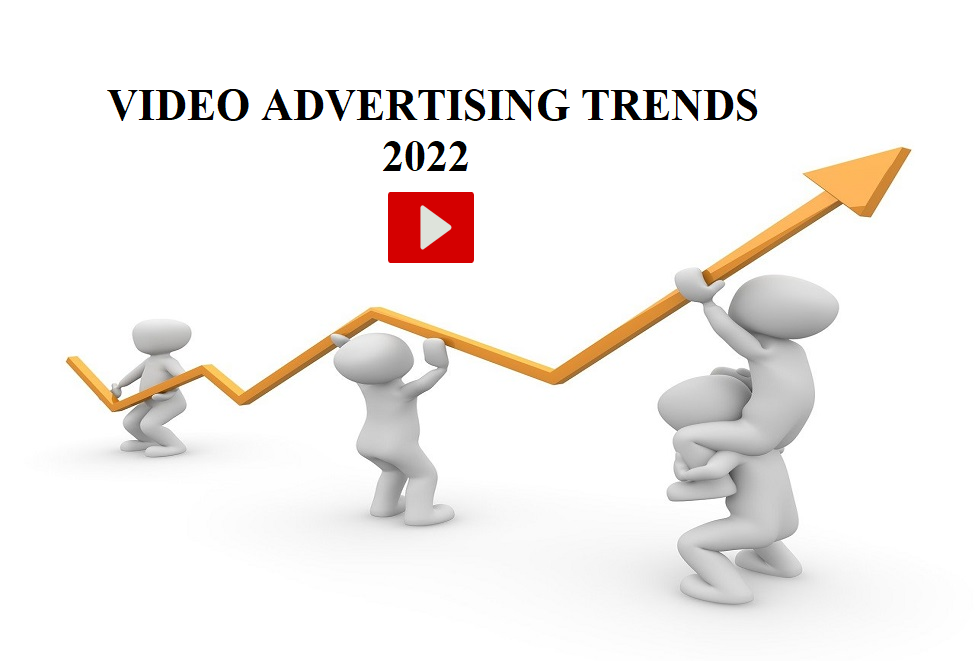
Last two years saw a surge in the investment in video advertising and other forms of digital marketing by businesses of all sizes. This surge was mainly fueled by the pandemic.
Video was used as a marketing tool by more than 85% of the businesses during the last year, i.e., 2021. 93% of marketing professionals have acknowledged that video helped them in increasing brand awareness in 2021. Below are discussed some of the top video advertising trends to watch for in the year 2022.
YouTube will Remain the Top Platform for Video Marketers
YouTube advertising has helped build countless number of brands. A recent survey of video marketing professionals has revealed that their most widely used platform is YouTube. More than 80% of video marketers consider YouTube as an effective channel. In 2021, YouTube was used by eighty-six percent of the video marketers, and eighty-eight percent of them are planning to use it in the year 2022.
Transition from Behavioral to Contextual Advertising will Increase
Due to the recent data privacy regulations and rising consumers’ awareness regarding online privacy, marketers are finding it increasingly difficult to track people via third-party cookies. The use of third-party cookies has been already discontinued by browsers such as Firefox, and by late 2023, Chrome browser will also discontinue these cookies.
Contextual advertising offers the best way to advertise on the internet as it does not involve the use of 3rd party cookies, and is highly effective, cost-efficient and does not invade consumers’ privacy. A recent survey shows that forty-nine percent of marketers are looking to contextual ad targeting in order to replace third-party cookies. This trend will rise sharply in future.
Investment in Connected TV Advertising will Rise
People are increasingly watching connected TV over traditional TV. It has been forecasted that the number of connected TV households in the US will increase to 110 million in 2022.
The October 2021 eMarketer forecast predicted that connected TV ad spending in the United States will increase to $19.10 billion in 2022 from $14.44 billion in 2021, and by the year 2024, it will be $29.50 billion, i.e., more than double the amount spent in 2021.
eMarketer has forecasted that Connected TV net ad revenue for YouTube in the United States will increase from $2.54 billion in 2021 to $3.17 billion in 2022. In the year 2022, the number of YouTube advertising campaigns for connected TV will rise significantly.
Use of Interactive Video Ads will Grow
Brands are already using interactive videos and their use is expected to rise increase in 2022. The statistics show that interactive videos offer a click through rate of over 11%. Majority of marketers think that interactive video will become a highly important part of their marketing strategy.
An interactive video allows a viewer to directly interact with the video itself. It provides a better user experience and allows engagement with a brand at a deeper level in comparison to traditional video. Marketers can create interactive YouTube video ads by making use of certain interactive features such as end screens, call to action buttons and shopping cards to help drive website visits, product purchases, installation of apps, etc.
More and More Marketers will Adopt AI-Powered Contextual Brand Suitability Technology
Various surveys have shown that ads of a brand that appear next to harmful or inappropriate content cast a negative impact on the minds of consumers. Marketers are now making efforts to not only avoid placement of ads against content that falls under generic unsafe categories like terrorism, but also against unsuitable content, i.e. content that does not suit the nature of the business.
Marketers are increasingly focusing on brand suitability and not only on brand safety. AI-powered contextual brand suitability technology allows video marketers to ensure ad placement against video content that is fully appropriate for brands. In 2022, more and more marketers will deploy this technology.
Final Words
By taking into account the above trends, marketers can create effective digital video advertising strategy for 2022 in order to run successful campaigns and boost ROI.







